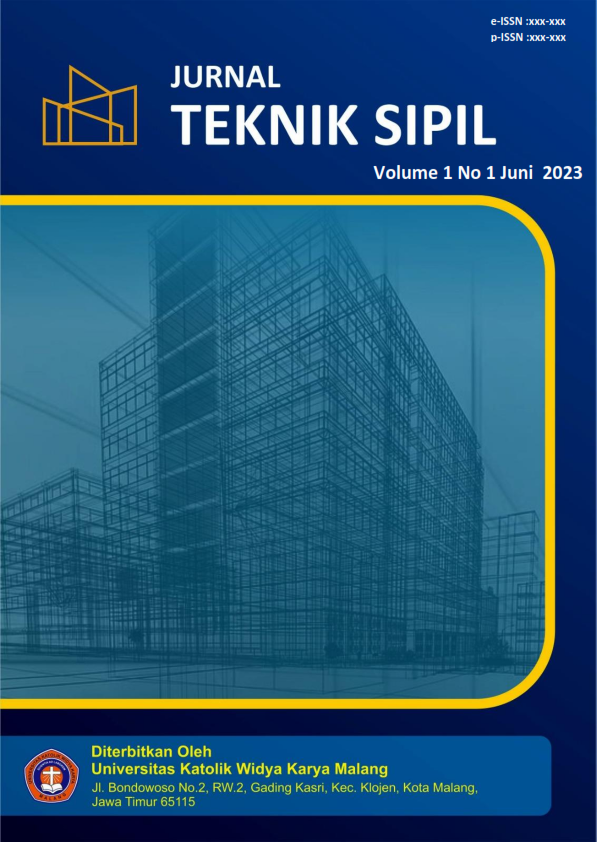Analisis Pengaruh Temperature Treatment Terhadap Kekuatan Tarik Komposit Plafon Rumput Payung (Cyperus Alternifolius) Matrix Epoxy
Keywords:
composite, cyperus alternifolius, temperature treatment, tensile stressAbstract
Ceiling is a building construction material that requires special attention from the impact it causes. Umbrella grass fiber composite is one of the material innovations that can be offered as a solution to replace ceilings, because umbrella grass fiber composites contain materials that are renewable and more environmentally friendly. In an effort to increase the strength of composite materials, temperature treatment is a method that can be used to optimize material conditions. In this study, an analysis of the effect of temperature treatment was carried out on the tensile strength of umbrella grass fiber ceiling composites (Cyperus alternifolius) with an epoxy matrix. The variations given are without heating process, 90°C, 100°C and 110°C. The results showed that the temperature treatment had little effect on increasing the strength of the material. The minimum percentage shown is less than 10%, which is 7.704% for maximum load and 5.111% for tensile stress. The trendline of maximum load and tensile stress due to temperature treatment tends to decrease in strength. This is because the parasol grass composite cracks on the thickness side during the heating process, the pattern of cracks shown appears to be getting bigger as the temperature increases. However, the relationship between the stress and strain values of the material at the temperature treatment variation obtained the best tensile test results at a temperature variation of 90˚C, with a stress value of 63.48 N/mm2 and a strain value of 0.26 mm
References
ASTM D638- 02a. (2003). Standard test method for tensile properties of plastics. In ASTM International (Vol. 08, pp. 46–58). https://doi.org/10.1520/D0638-14.1
Bongarde, U. S., & Shinde, V. D. (2014). Review on natural fibers reinforcement polymer composites_Bongarde US 2014. International Journal of Engineering Science and Innovative Technology (IJESIT), 3(2), 431–436.
Diharjo, K. (2013). Pengaruh Perlakuan Alkali terhadap Sifat Tarik Bahan Komposit Serat Rami-Polyester. Chemical Engineering, 6.
Inanta, C. A. (2019). ANALISIS PERLAKUAN ALKALI SERAT RUMPUT PAYUNG (Cyperus Alternifolius) TERHADAP KEKUATAN TARIK PLAFON KOMPOSIT DENGAN MATRIX EPOXY. Chemical Engineering, 199–219. https://doi.org/10.1055/s-2008-1040325
Maryanti, B., As, A., & Wahyudi, S. (2011). Pengaruh Alkalisasi Komposit Serat Kelapa-Poliester Terhadap Kekuatan Tarik. Rekayasa Mesin Universitas Brawijaya, 2(2), 123–129.
https://media.neliti.com/media/publications/128471-ID-pengaruh-alkalisasi-komposit-serat-kelap.pdf
Mohammed, L., Ansari, M. N. M., Pua, G., Jawaid, M., & Islam, M. S. (2015). A Review on Natural Fiber Reinforced Polymer Composite and Its Applications. International Journal of Polymer Science, 2015. https://doi.org/10.1155/2015/243947
Nayiroh, N. (2013). TEKNOLOGI MATERIAL KOMPOSIT. 302.
Nurudin, A., As, A., & Atmodjo, W. Y. (2011). Karakterisasi Kekuatan Mekanik Komposit Berpenguat Serat Kulit Waru ( Hibiscus Tiliaceus ) Kontinyu Laminat Dengan Perlakuan Alkali Bermatriks Polyester. Jurnal Rekayasa Mesin, 2(3), 209–217.
Oroh, J., Sappu, F. P., & Lumintang, R. (2013). Analisis Mekanik Material Komposit Serat Sabut Kelapa. d.
Prianggoro, H. (2009). Rumput Payung_Sibandel yang Fleksibel - Kompas.Pdf [Internet]. Kompas Tekno.
Roberto, E. (2017). Pengaruh temperatur curing pada sifat komposit berpenguat serat buah pinang dengan orientasi serat acak.
Salim, R. (2016). STUDI PENGARUH PERLAKUAN ALKALI DAN PANAS TERHADAP SIFAT MEKANIK SERAT KENAF UNTUK BAHAN KOMPOSIT. International Journal of Engineering Science and Innovative Technology (IJESIT), 1–11.
Samara, D. (2002). Asbes sebagai faktor risiko mesotelioma pada pekerja yang terpajan asbes. Jurnal Kedokteran Trisakti, 21(3), 91–97.
Sari, P., Sudarno, & Wisnu, I. (2015). PENGARUH JUMLAH TANAMAN CYPERUS ALTERNIFOLIUS DAN WAKTU TINGGAL LIMBAH DALAM PENYISIHAN KADAR AMMONIAK, NITRIT, DAN NITRAT.
Sihotang, H. (2016). KARASTERISTIK CURING 80oC, 100oC dan 120oC KOMPOSIT SERABUT KELAPA.
Suwanto, B. (2006). Pengaruh Temperatur Post - Curing Terhadap Kekuatan Tarik Komposit Epoksi Resin Yang Diperkuat Woven Serat Pisang. Chemical Engineering, 160(8), 2010.
Tambyrajah, D. (2015). Indulge & Explore Natural Fiber Composites Preface. 122.
Yoedono, B. S., Santjojo, D. J. D. H., & Martino, B. (2017). ANALISIS KEKUATAN LENTUR PLAFON KOMPOSIT SERAT RUMPUT PAYUNG ( Cyperus Alternifolius ) DENGAN MATRIK EPOXY. Senaspro 2017, 2, 213–219. http://research-report.umm.ac.id/index.php/research-report/article/view/1215
Yoedono, B. S., Sunik, Inanta, C. A., & Rizal, R. (2021). PENGARUH ALKALINISASI SERAT TERHADAP KEKUATAN MEKANIK PLAFON KOMPOSIT SERAT RUMPUT PAYUNG (CYPERUS ALTERNIFOLIUS) DENGAN MATRIKS EPOXY. Dinamika Rekayasa, 17(1), 45–51. https://doi.org/http://dx.doi.org/10.20884/1.dr.2021.17.1.308















